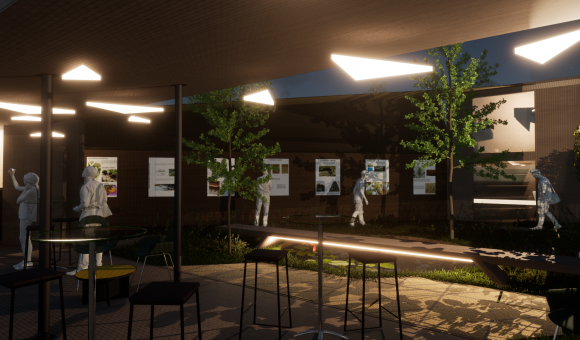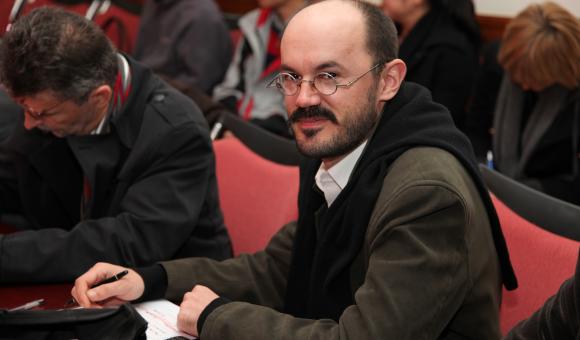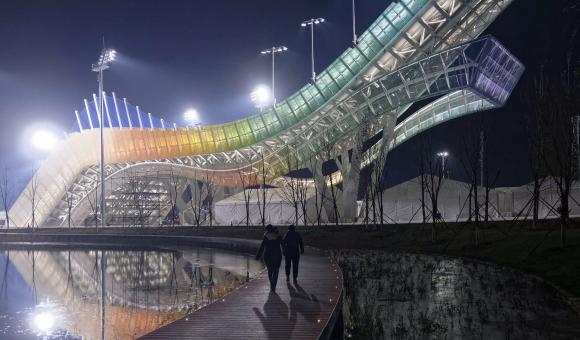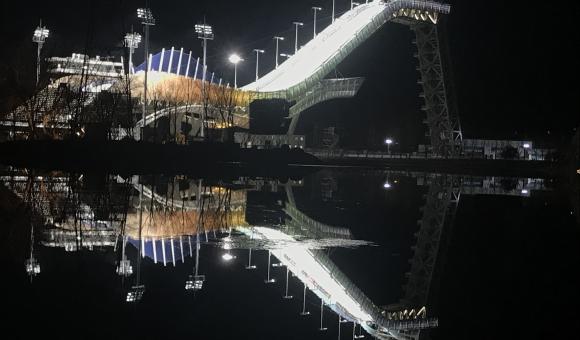
Nicolas Godelet, an architect and engineer from the Condroz region in Namur, fell in love with China at a very young age. He has lived and worked in Beijing for over twenty years and works on the wildest projects there, standing out thanks to his sustainable vision. His latest design : a sixty-metre-high ski ramp for the Olympic Games in Beijing – Big Air Shougang. Closer to home, he is also designing the Belgian pavilion for the Floriade Expo in Almere in the Netherlands, one of the largest horticultural exhibitions in the world. He already created the Belgian pavilion-garden at the Floriade Expo in Beijing in 2019. This is an opportunity for us to showcase this passionate and intriguing polyglot.
Upon finishing his studies in 2000, Nicolas Godelet wanted to improve his knowledge of Chinese and managed to obtain a scholarship to study at the University of Foreign Languages in Beijing.
His job is his passion; being an architect is not just a profession, but a life philosophy that he applies in his work. All of his trips and meetings serve as sources of inspiration. While the financial return of certain projects is not up to scratch, the richness of his work lies elsewhere: collaborations, research or leaving a lasting mark on the world with projects that will outlive him.
Nicolas has his own view of sustainability: ‘Sustainability means being able to integrate into a place, with everything that makes it unique. We have to consider society, cultural customs, history, architecture, cycles, the natural world, sources, mobility and, lastly, technology.’ Being a Belgian who speaks Chinese fluently and understands local culture allows him to stand out in his field and, thanks to his skills as an architect and engineer, he has been able to underscore the technological reputation of Belgium and Wallonia abroad.
Big Air Shougang* for the Beijing Winter Olympics this year is not Nicolas Godelet’s only success in China. Far from it. In addition to participating in the National Centre for the Performing Arts in Beijing, the Beijing National Stadium and the restoration of the Shougang metallurgical site into a cultural district, there is also the Chang’An bridge or the construction of the new Belgian embassy in Beijing. Yet again, the focus on recovery and the environmental footprint is at the centre of this project, with many elements of the former building having been recovered and the second floor being built from wood, which is unique in the Chinese capital.
For the Olympic ramp, sustainability is still at the core of the project. This is an ambitious project to transform industrial heritage, with the aim of revitalising civilian life at a century-old steel mill, reconnecting the city to the Yongding River and rejuvenating the run-down natural environment. The Shougang Big Air plan connects the site of the Winter Olympics with the transformation of a key portion of the former steel mill, focusing on the cooling towers, an oxygen-production plant and a cooling pond.
It is also the only new outdoor sports infrastructure that has been built in the city for the Olympic Games. The Big Air ramp was not originally supposed to be located in the middle of the city, but, as a snowboarder, Nicolas Godelet wanted to make it accessible for everyone and ensure that young people could practice on the ramp with a simple metro ticket worth fifty cents. ‘I helped Shougang to convince the International Ski Federation from the Olympic Committee to organise this event in the city.’ The Big Air ramp will also be used for other events, as the structure can be used for different purposes, such as concerts or other extreme sports.
Sustainability will once again take centre stage at the Floriade Expo in Almere. The Belgian pavilion, which has been designed by Nicolas Godelet and a team of freelancers, is integrated into a garden, so we are talking about landscapes, horticulture and agriculture. Belgium has two specific features in its fields. On one hand, a high level of technology for horticultural production and, on the other hand, a sustainable attitude that redresses the balance between the actions of man/nature. This project aims to be completely regenerable, since, at the end of the Floriade Expo, the pavilion may be razed without leaving any waste. This is possible thanks to the three main materials used: wood, recycled earth from construction sites and compostable bioplastic, which is completely different from so-called ‘bioplastic’ bags. The bioplastic used is made from starch, algae and natural elements. The unique element is that the entire landscape will be 70% edible.
‘This is not just an exhibition, but a garden where you will want to spend time, with Belgian items like beer taps, a bar, a terrace, games for kids and more,’ explains Nicolas Godelet.
Although he is working on more projects internationally, the Namur-based architect remains very attached to his region. Originally from Dorinne in the Condroz region, he established his NG-Lab office there, in the former restaurant owned by his parents. Several future projects are already being lined up, in particular in Wallonia with Air du Temps, the two-star restaurant in Eghezée, and, on the other side of the world (n Japan this time), the potential construction of the Belgium pavilion at the next Universal Exhibition, which will be held in Osaka.
* Team: Structural and sports consultant: NG-LAB/Archisteel
Nicolas GODELET, Head architect, engineer
Bernard VIRY, Structural consultant
Mengfei SHEN, Architect
Gauthier RALET, Construction engineer
Dechen LV, Architect
Architectural design: Architectural Design and Research Institute of Tsinghua University (THAD)
Design of plans for execution: Beijing Shougang International Engineering Technology Co., Ltd. (BSIET)/Hangzhou Zhonglian Zhujing Architectural Design Co., Ltd.
Structural consultant: Beijing Institute of Architectural Design (BIAD) – Complex Structure Research Institute
Slope-profile consultant and sports consultant: Schneestern GmbH & Co. KG
Lighting design: Atelier Zhang Xin
Landscape design: Architectural Design and Research Institute of Tsinghua University (THAD)
Programme design: Beijing Shougang Automation Information Technology Co., Ltd
** Director of NG-lab: NICOLAS GODELET Project management: NICOLAS GEUDVERT Landscape architect: LAURENT DEENEN Architect: FARKAS ORSZAGH Trainee architect: PHILIPPE SADZOT




